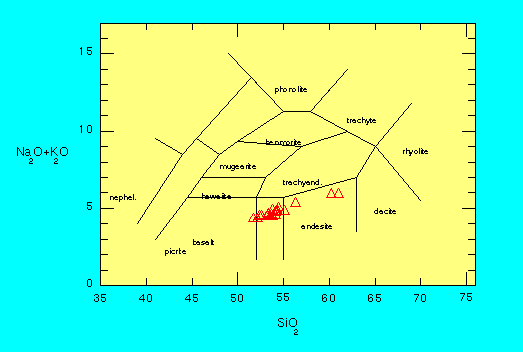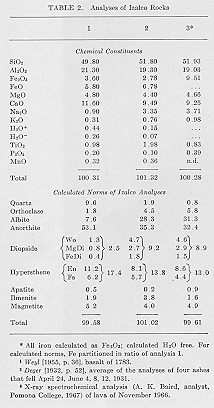
The October-November 1966 lava is petrographically similar to these older lavas. It is a vesicular porphyritic basalt. Bytownite phenocrysts, average size 1 mm, comprise 30% of the rock, showing albite, carlsbad, and baveno twins and normal zoning. Subhedral olivine phenocrysts conmprise 4% and twinned augite phenocrysts 1%. The rock is 65% hypocrystaline groundmass. Previously published analyses and a new analysius of Novemebr 1966 lava, together with their norms are listed in Table 2.
The basalt of the 1966 flow (Table 2, column 3) is a circumoceanic type according to Chayes [1964, p. 1580] because it contains less than 1.75% TiO2. It falls in the high alumina basalt group of Kuno [1960, pp. 136-137] because of its Al2O3, SiO2, and Na2O + K2O content. It is like that of most other Central American basalts. Analyses compiled by Meyer-Abich and McBirney [Mooser et al., 1958], and those is a more recent compilation of nicaraguan volcanic rocks [McBirney and Williams, 1965] indicate that almost all recent Central American basalts have the chemical characteristic of Cenozoic basalts of circumoceanic areas and of the high alumina group.

Cox-Bell-Pank (1979) diagram, which describes the rock types for several Izalco lava samples.
The petrography is also discussed by Pontier (1979). "Petrography of the samples from Izalco and Santa Ana was observed in thin section. The modal analyses of 1000 counts for each thin section for Izalco are given in Table 2 in the text. A description of the particular phenocryst minerals follows for each volcano.
In Izalco optically determined anorthite content in plagioclase ranges from 55 to 75 percent. The crystals are from 1 to 3 mm long, with prominent zoning. Some of the zones are outlined by dusty inclusions of opaque minerals and other clear, low-birefringence inclusions which may be apatite. The plagioclase phenocrysts are usually euhedral a;nd always polysynthetically twinned.
Pyroxenes include augite and hypersthene. They are difficult to distinguish in plane-polarized light because both are faintly colored. The augite is pale green and the hypersthene is faintly pleochroic. Hypersthene is only observed in samples bearing more than 55 wt. % silica, namely samples IZ-100, 102, 107, 121, and 122. Exsolution lamellae are common in augite and inclusions of opaque oxide, olivine, and apatite are also found. The size ranges from .5 to 3mm, and the shape is anhedral to euhedral.
Olivine is present in all samples, ranging in size from groundmass (.1 mm) to 1 mm, but most crystals are about .5mm. Olivine is always rimmed by pyroxene or opaque oxide and in a few samples is altered to iddingsite. Opaque inclusions sometimes occur. Only one case of zoning was observed in IZ-103.
An opaque mineral, probably Ti-rich magnetite, is present in all samples. It is groundmass size to .5mm maximum size. The magnetite in IZ-102 contains irregular, isotropic, inclusions which may be glass. It is the least abundant phenocryst. Izalco samples are almost all seriate porphyritic with crystalline groundmass, so that they are essentially holocrystalline."

